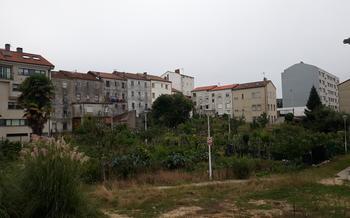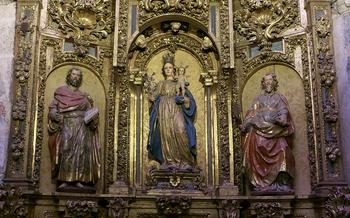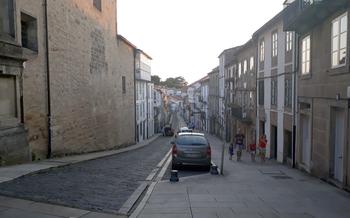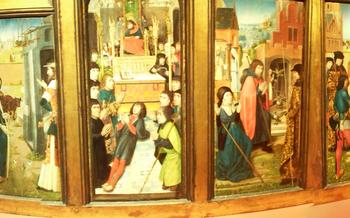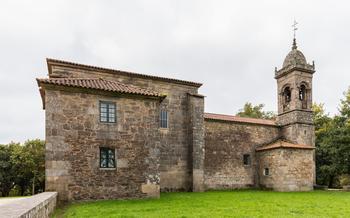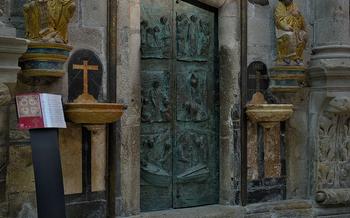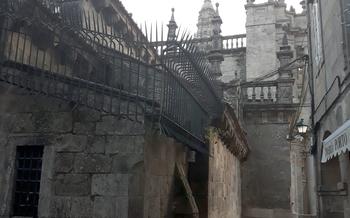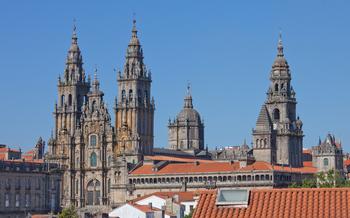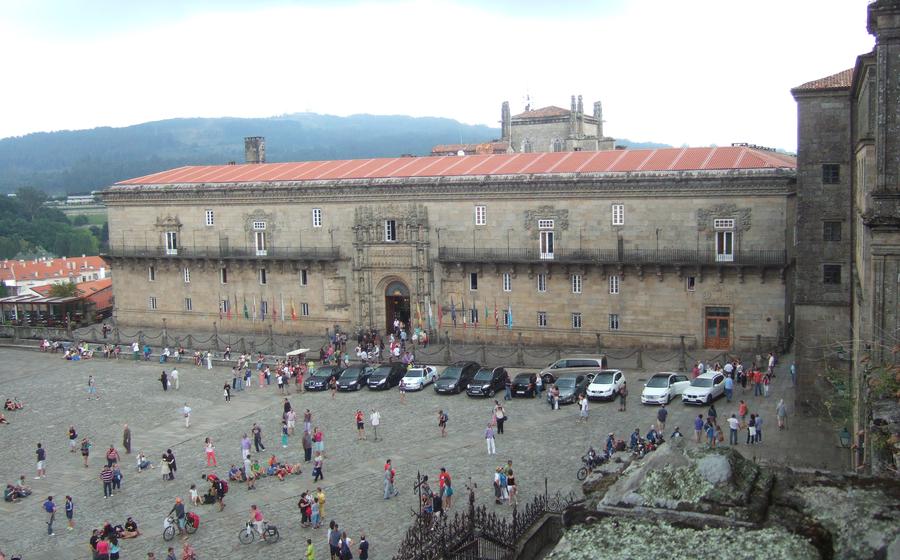
Convent of San Domingos de Bonaval Historical convent
- Atop Mount Pedroso
- Architecture and Art
- The Gothic Cloister
- San Domingos De Bonaval Museum
- Pilgrims' Hostel
- Festival of San Domingos
- Pilgrimage to Santiago
- Urban Legends
- Nearby Attractions
- Local Cuisine
- Accommodation Options
- Transportation
- Practical Tips
- Virtual Tour
- Insider Tip
Atop Mount Pedroso
Perched atop Mount Pedroso, the Convent of San Domingos de Bonaval offers a glimpse into the rich history and spiritual heritage of Santiago de Compostela. Founded in the 12th century, the convent has witnessed centuries of change, from its humble beginnings as a small hermitage to its transformation into a grand religious complex.
Legends abound about the origins of the convent. One tale speaks of a miraculous vision experienced by a shepherd named Pedro, who saw a bright light emanating from the mountaintop. Guided by this divine sign, he discovered a hidden cave where he found a statue of the Virgin Mary. Inspired by this revelation, he built a small chapel on the spot, which eventually grew into the Convent of San Domingos de Bonaval.
The convent's strategic location atop Mount Pedroso offers breathtaking panoramic views of the surrounding countryside. From its elevated perch, visitors can admire the rolling hills, lush forests, and distant spires of Santiago de Compostela. The views from the convent are particularly stunning at sunset, when the sky transforms into a kaleidoscope of colors, casting a warm glow over the landscape.
Architecture and Art
The Convent of San Domingos de Bonaval boasts a captivating blend of Romanesque and Gothic architectural styles. Its Romanesque origins are evident in the sturdy walls, round arches, and barrel vaults that create a sense of grandeur. The Gothic influence, added later, can be seen in the pointed arches, ribbed vaults, and intricate carvings that adorn the building's facade and interior.
The convent's interior walls are graced with sculptures and paintings that showcase the artistic prowess of the medieval period. These artworks depict scenes from the Bible, the lives of saints, and historical events, offering a glimpse into the beliefs and values of the time. Visitors can admire the vibrant colors, expressive figures, and intricate details of these masterpieces, which have been meticulously preserved over the centuries.
The convent's restoration in the 20th century has further enhanced its architectural and artistic beauty. Careful attention was paid to preserving the original features while incorporating modern elements that complement the historic structure. As a result, the Convent of San Domingos de Bonaval stands as a testament to the enduring legacy of medieval craftsmanship and the harmonious coexistence of different architectural styles.
The Gothic Cloister
The Gothic cloister, built in the 15th century, is a testament to the architectural prowess of the era. Its graceful arches, intricate carvings, and serene atmosphere make it an oasis of tranquility within the bustling city. The cloister served as a place for monks to gather, meditate, and study.
Historical Significance
The cloister holds immense historical significance, having witnessed centuries of religious devotion and communal life. It was a central part of the monastery's daily routine, where monks would gather for prayers, readings, and contemplation. The cloister also served as a place for teaching and learning, with monks engaging in intellectual pursuits and passing on their knowledge to younger generations.
Architectural Features
The Gothic cloister showcases exquisite architectural details that blend harmoniously with the overall design of the convent. Its pointed arches, ribbed vaults, and intricate tracery create a sense of lightness and elegance. The slender columns and delicate ornamentation lend a graceful touch to the cloister, making it a masterpiece of Gothic architecture.
Gardens and Fountains
The cloister's serene atmosphere is further enhanced by its beautifully manicured gardens and tranquil fountains. The lush greenery, colorful flowers, and gentle sounds of water create a soothing ambiance that invites visitors to pause and reflect. The gardens provide a haven for contemplation and a respite from the bustling city outside.
Peaceful Atmosphere
The Gothic cloister exudes a palpable sense of peace and tranquility. Its harmonious architecture, serene gardens, and the gentle murmur of the fountains create an environment conducive to meditation and spiritual reflection. Visitors can find solace and respite within the cloister's embrace, allowing them to connect with their inner selves and experience a moment of profound serenity.
San Domingos De Bonaval Museum
The Convent of San Domingos de Bonaval is home to a fascinating museum that preserves and showcases the rich cultural and historical heritage of the site. The exhibits provide an intriguing glimpse into the past, with a diverse collection of artifacts that narrate the story of the convent and its significance.
Exhibitions The museum's exhibitions are thoughtfully curated, presenting a journey through time that begins with the convent's humble origins and continues through its various transformations. Visitors can explore the history of the Dominican Order, the role of the convent in the pilgrimage route to Santiago, and the artistic and architectural treasures that adorn the complex.
Archeological Artifacts Among the highlights of the museum are the archeological artifacts uncovered during excavations on the site. These relics, such as ancient pottery, tools, and coins, offer valuable insights into the daily lives of the monks and the surrounding community during different periods.
Religious Art The museum also boasts an impressive collection of religious art, including sculptures, paintings, and tapestries. These artworks, created by talented local artisans, depict scenes from the Bible, the lives of saints, and the history of the Catholic Church.
Multimedia Displays To enhance the visitor experience, the museum incorporates interactive multimedia displays that bring the past to life. These engaging exhibits utilize touchscreens, audio guides, and virtual reality to provide additional information, stories, and immersive experiences.
Pilgrims' Hostel
The Convent of San Domingos de Bonaval also serves as a welcoming and well-equipped pilgrims' hostel. This tradition dates back to the 15th century when the convent provided shelter to weary pilgrims making their way to the revered Cathedral of Santiago.
The hostel offers basic yet comfortable accommodations, with dormitory-style rooms and shared facilities, ensuring a sense of camaraderie among the pilgrims. The atmosphere is one of simplicity, fostering a spirit of community and shared experiences.
A highlight for pilgrims is the daily Pilgrim's Mass, held within the convent's historic chapel. This solemn ceremony allows pilgrims to reflect on their journey, seek blessings, and find spiritual solace before continuing their pilgrimage.
The hostel operates on a donation basis, relying on the generosity of pilgrims and visitors to sustain its operations. This system embodies the spirit of the Camino, where pilgrims often rely on the kindness and support of others along the way.
Festival of San Domingos
The Festival of San Domingos, held annually in August, is a vibrant celebration that honors the patron saint of the convent. The festivities kick off with a solemn procession, where the statue of San Domingos is paraded through the streets, accompanied by traditional music and dancing.
The streets come alive with vibrant parades showcasing colorful costumes, local musicians playing traditional Galician tunes, and energetic dancing that reflects the region's rich cultural heritage. The festival encapsulates the essence of Santiago's cultural identity and offers a glimpse into the deep-rooted traditions of the region.
During the festival, the convent opens its doors to visitors, allowing them to witness the grandeur of the architecture and the beauty of the interior. Local artisans set up stalls showcasing their handcrafted goods, offering visitors a chance to take home unique souvenirs and support the local economy.
The festival is not just a religious celebration but also a time for communal bonding and merriment. Locals and visitors alike come together to share food, drinks, and stories, creating a warm and welcoming atmosphere. The festival is an excellent opportunity to immerse oneself in the vibrant culture of Santiago de Compostela and experience the infectious energy of this joyous celebration.
Pilgrimage to Santiago
The Convent of San Domingos de Bonaval stands as a profound testament to the historical and cultural significance of the pilgrimage to Santiago de Compostela. The Camino de Santiago, also known as the Way of St. James, is an ancient network of pilgrimage routes that converge in the city of Santiago, where the remains of St. James the Great, one of Jesus's twelve apostles, are believed to be buried. For centuries, countless pilgrims have embarked on this spiritual journey, traversing diverse landscapes and seeking enlightenment and spiritual fulfillment.
The Camino de Santiago holds immense religious and historical importance, having been recognized by UNESCO as a World Heritage Site. Pilgrims from all walks of life and corners of the world undertake this pilgrimage, often as a symbol of faith, penance, or personal growth. The route is marked by landmarks, churches, and hostels that provide shelter and sustenance to weary travelers.
Along the way, pilgrims encounter a rich tapestry of cultures, traditions, and landscapes, fostering a sense of community and cultural exchange. The pilgrimage has played a pivotal role in shaping the history, art, and architecture of the regions it traverses, leaving an indelible mark on the cultural heritage of Spain and beyond.
Urban Legends
The Convent of San Domingos de Bonaval is steeped in mystery and folklore, with several intriguing urban legends associated with it. One of the most famous tales is The Miraculous Cross, which tells the story of a wooden cross that was found floating on the Sarela River. The cross was brought to the convent and placed in the church, where it is said to have performed miracles and granted wishes.
Another popular legend is The Devil's Footprint, which claims that the devil once visited the convent and left his footprint in one of the stones of the cloister. The footprint is still visible today and is said to bring bad luck to anyone who steps on it.
Finally, there is the legend of The Talking Skull, which tells the story of a skull that was found in the convent's ossuary. The skull is said to have the ability to speak and has been known to give advice and warnings to those who listen. Whether these legends are true or not, they add an air of mystery and intrigue to the Convent of San Domingos de Bonaval, making it a truly unique and fascinating place to visit.
Nearby Attractions
Strolling through the quaint streets of Santiago de Compostela, visitors discover a plethora of captivating attractions that complement their visit to the Convent of San Domingos de Bonaval. A short walk away lies the Plaza del Obradoiro, the heart of the city and home to the majestic Santiago Cathedral, a UNESCO World Heritage Site. The cathedral, with its awe-inspiring Romanesque and Gothic architecture, boasts an opulent interior adorned with intricate sculptures, stained glass windows, and a grand altar.
Within the cathedral complex, visitors can delve into the Museo de la Catedral, showcasing a treasure trove of religious artifacts, tapestries, and paintings that narrate the history and significance of the cathedral. A stroll through the Parque de la Alameda offers a tranquil respite from the city's bustle, with its verdant gardens, serene ponds, and sculptures. This urban oasis invites visitors to relax, soak in the serene atmosphere, and appreciate the beauty of nature amidst the historic cityscape.
Local Cuisine
Galician gastronomy is a culinary journey that celebrates fresh seafood, hearty stews, and traditional pastries. Indulge in the flavors of pulpo a la Gallega, a tender octopus dish prepared with paprika, olive oil, and sea salt. Savor the crispy and flaky empanada Gallega, a savory pastry filled with seafood, meat, or vegetables. Try the rustic caldo Gallego, a hearty soup made with kale, potatoes, and pork. For a sweet treat, try the tarta de Santiago, a moist almond cake dusted with powdered sugar and adorned with the cross of Santiago. Don't miss the opportunity to explore the local markets, where you can find fresh produce, artisanal cheeses, and traditional Galician products. Immerse yourself in the vibrant culinary scene of Santiago de Compostela and savor the flavors of this region's rich heritage.
Accommodation Options
Santiago de Compostela offers a wide range of accommodation options to suit various budgets and preferences.
Paradores: For a luxurious stay, consider booking a room at one of the city's two paradores, historic buildings converted into charming hotels. The Parador de Santiago de Compostela is located right next to the cathedral, offering stunning views, while the Parador de Santo Estevo is set in a former monastery just outside the city center.
Hostels: For budget-minded travelers, there are numerous hostels in Santiago, catering to pilgrims and backpackers. These hostels offer dormitory-style rooms or private rooms, often with shared facilities.
Hotels: If you prefer a more traditional hotel experience, there are plenty of options available in Santiago. From family-run guesthouses to modern business hotels, you're sure to find something that meets your needs.
Apartments: For a more independent stay, consider renting an apartment in Santiago. This option is ideal for families or groups looking for a home away from home.
No matter your budget or preferences, you're sure to find the perfect accommodation in Santiago de Compostela.
Transportation
Getting to Santiago
Santiago de Compostela is well-connected by air, rail, and road. The city's airport, Santiago de Compostela Airport (SCQ), is located just 10 kilometers from the city center and offers flights to major cities in Spain and Europe. The city is also served by a high-speed rail line, the AVE, which connects it to Madrid, Barcelona, and other major Spanish cities. By road, Santiago de Compostela is accessible via the A-6 motorway.
Public Transportation
Once in Santiago de Compostela, getting around is easy thanks to the city's efficient public transportation system. The city has a comprehensive bus network that connects all major neighborhoods and attractions. Buses run frequently and are affordable. Taxis are also readily available and offer a convenient way to get around, especially for shorter distances.
Renting a Car
If you prefer the flexibility of having your own transportation, you can rent a car in Santiago de Compostela. Several car rental agencies are located at the airport and in the city center. Renting a car is a good option if you plan to explore the surrounding countryside or make day trips to nearby cities.
Airport Information
Santiago de Compostela Airport (SCQ) is a modern and well-equipped airport. It has a variety of shops, restaurants, and cafes, as well as currency exchange services and ATMs. The airport is also well-connected to the city center by bus and taxi.
Practical Tips
Before embarking on your journey to the Convent of San Domingos de Bonaval, it is essential to be aware of certain practicalities to ensure a smooth and enjoyable visit.
-
Dress Code: While there is no strict dress code, visitors are expected to dress respectfully when entering the convent's sacred spaces. It is advisable to avoid wearing shorts, tank tops, or revealing clothing.
-
Visiting Hours: The convent is open to the public from Tuesday to Sunday, with specific hours varying depending on the time of year. It is recommended to check the official website or contact the convent directly for the most up-to-date information.
-
Accessibility: The convent is wheelchair accessible, with ramps and elevators available to facilitate movement throughout the complex. Visitors with disabilities can request assistance from the staff if needed.
-
Photography: Photography is generally allowed within the convent, but visitors are kindly requested to be respectful of the privacy of other guests and avoid using flash photography in the museum and cloister areas.
Virtual Tour
Various online resources provide virtual tours of the Convent of San Domingos de Bonaval, allowing you to explore this historic site from the comfort of your home. These tours offer immersive experiences with 360-degree views, enabling you to navigate through the convent's cloisters, admire the intricate sculptures, and delve into its rich history.
Interactive exhibitions and multimedia displays further enhance the virtual experience by providing detailed information about the convent's architecture, art, and religious significance. You can also virtually participate in a pilgrim's mass, experiencing the spiritual atmosphere of this sacred place.
For those unable to make the physical pilgrimage to Santiago de Compostela, these virtual tours offer an accessible and engaging way to connect with the Camino and explore the cultural heritage of Spain.
Insider Tip
If you seek a hidden gem, venture beyond the main tourist areas to discover the enchanting corners of Santiago. Stroll through the narrow cobbled streets, where you'll uncover charming boutiques, local markets, and hidden plazas. These secret spots offer a glimpse into the city's authentic character and provide an opportunity to connect with the locals.
Santiago is a city that comes alive at night, with its vibrant energy spilling onto the streets. As the sun sets, the city transforms into a hub of activity, with locals and visitors alike filling the plazas, bars, and restaurants. Indulge in the local cuisine, savor the flavors of Galician gastronomy, and experience the infectious rhythm of traditional music that fills the air.
To avoid the crowds and fully immerse yourself in the city's charm, plan your visit during the shoulder seasons (spring and autumn) or consider exploring Santiago on a weekday. This will allow you to enjoy a more intimate and authentic experience, without the throngs of tourists.
When shopping for souvenirs, venture beyond the tourist traps and seek out local markets and artisan shops. Here you'll find unique and handcrafted items that truly represent the spirit of Santiago. From intricate ceramics to delicate lacework, these treasures will serve as lasting mementos of your journey.
